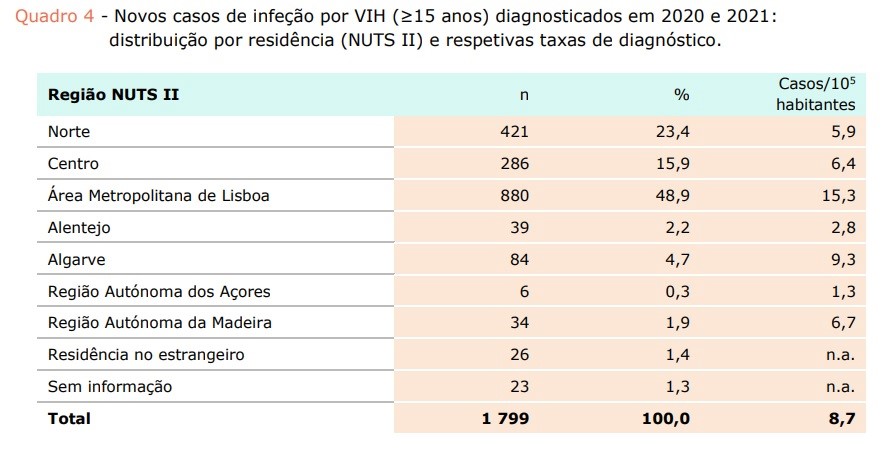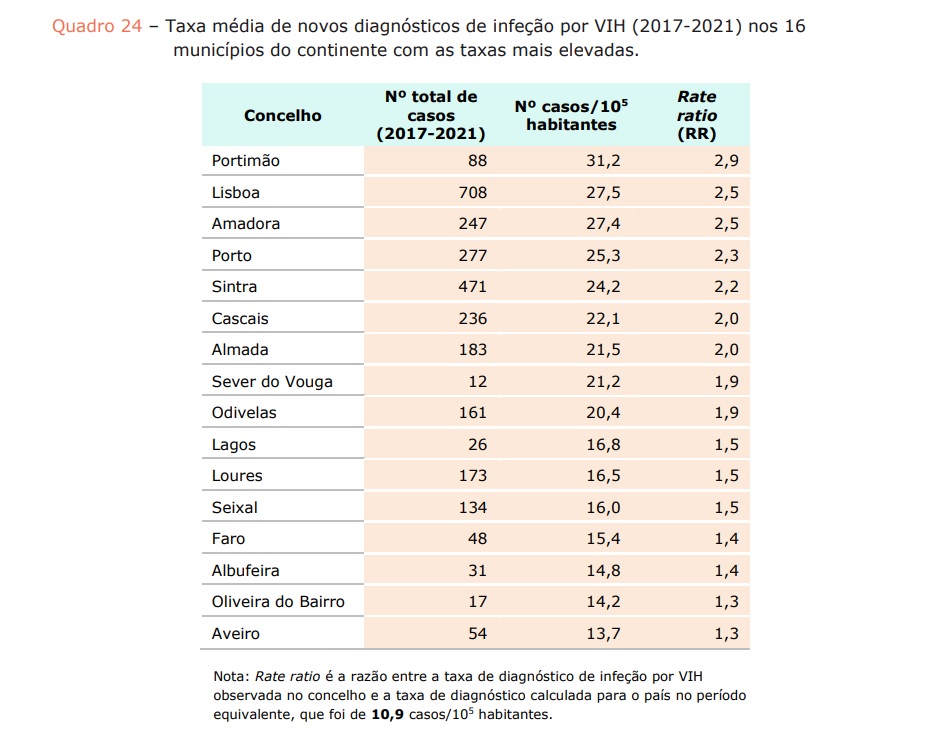The Algarve had, as in 2019, in 2020 and 2021 the second highest rate of diagnoses of people with HIV infection (human immunodeficiency virus) in the country, with 9.3 cases per 100,000 inhabitants.
The data contained in the “Report of HIV infection in Portugal – 2022”, which will be presented today by the Directorate General of Health and the National Institute of Health Doutor Ricardo Jorge.
The document, which collects data for the years 2020 and 2021, shows how the metropolitan area of Lisbon is the area with the highest percentage of new cases (880, which equates to 15.3 infections per 100,000 inhabitants).
However, in absolute terms of new cases, the Algarve appears to be less prominent, with 84 new cases of HIV infection diagnosed (aged 15 or older) in 2020 and 2021, surpassed by Lisbon (880). ) and the north (421) and the center. (286).
By region An analysis of the rates of new diagnoses by region revealed that the three provinces with the highest rates were: Lisbon (16.6 cases/105 population), Faro (9.7 cases/105 population) and Setubal (9.2 cases/105 population).
In the last report for 2019, the Algarve recorded 59 cases, which equates to 13.5 infections per 100,000 inhabitants.
Despite everything, the data on HIV, which, if left untreated, can lead to AIDS (acquired immunodeficiency syndrome), is still encouraging in Portugal.
The number of new cases decreased again in 2020 and 2021 (total 1803), maintaining the downward trend already observed since 2000. In other words, 1999 ended, when 3358 HIV cases were diagnosed in Portugal.
Thus, the report on the evolution of infection in Portugal, which is presented in the week of World AIDS Day, reveals a 44% decrease in the number of new cases of HIV infection, and a 66% decrease in new cases. AIDS between 2012 and 2021.
The DGS and INSA document also analyze rates of new HIV cases at the county level.
Although the three municipalities with the highest number of new cases are, in descending order, Lisbon, Sintra and Porto, Portimao is the city with the highest rate of new infections (31.2 cases per 100,000 inhabitants).
There are three more municipalities in the Algarve on the list: Lagos, Albufeira and Faro.
At the national level, the majority (71.8%) of new infections were recorded in adolescents and adults (15 years) in men (2.5 cases per case in women) and the average age at the time of diagnosis was 39 years.
In 63.6% of the new cases the people were between 25 and 49 years old and in 27.6% they were 50 years or older. In the period under review, 4 cases of HIV infection were reported among children (2 cases in 2020 and 2 cases in 2021).
Although heterosexual transmission remains the most common (51.8%), cases in MSM correspond to the majority of new diagnoses in men (56.0%).
In terms of deaths, 298 deaths were reported in people living with HIV (148 in 2020 and 150 in 2021). In 24.5% of deaths, the time since diagnosis was greater than 20 years.
And by analyzing the accumulated data, from 1983 to December 31, 2021, 64,257 cases of HIV infection were identified in Portugal, of which 23,399 reached the stage of AIDS and 15,555 died.
This report is the result of collaborative work between DGS, INSA, SPMS, hospitals and professionals, based on the process of retrieving overdue notifications of new cases of HIV infection, following the restrictions that have characterized the epidemic.
Click here to view the report “HIV Infection and AIDS in Portugal – 2020 and 2021” in full (PDF).

“Writer. Analyst. Avid travel maven. Devoted twitter guru. Unapologetic pop culture expert. General zombie enthusiast.”





